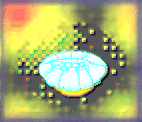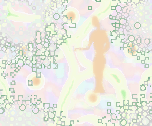|
The origin of Japanese culture and, the world view as its logical conclusion. |
 | ||||
| Hiromasa Noguti. Mail-address cotosiro@js6.so-net.ne.jp. September 13, 2003. This was renewed in March 27, 2004. Since this English edition was the unsatisfactory translation and performance, this was rewritten now. January 22, 2005. This was retranslated in April 10, 2008. | |||||
|
3. The soul like Jomon lurking to Japanese gods and goddesses. 3-4. The land for the gods and goddesses. |
|||||
|
In the Yakumo village of Tottori Prefecture, there is the Kumano shrine to be said to exist since the age of the gods. And, it is said that the god enshrined to this shrine is "Kamuroki-kumanu-nho-kusi-mikenu", is the very historic god. If so, it seems it can decipher the name of this unidentifiable god with using the Jomon language same as Takami-musubi and Kan-musubi. Thereupon, it started to decipher this name in the dictionary of Ainu's language compiled by Dr. Masiho Tiri. Needless to say, it is because it seems Ainu's language is similar to Jomon language. And, it could decipher this name fast beyond expectation. When it finished the deciphering, it is that it noticed it can read it with the pronunciation like "Kamuy-rok-kuma-nesir-mek-ka" with Ainu's language. And, it could notice what does this name mean, in the reason it states in the following. In passing, the "Kamuy-rok" in Ainu's language means that the gods and goddesses are sitting on something. The "rok" is the verb used in plural. And, since the "kuma" is the sideways long wooden stick used to hang the fishes, and so on, it also is used as the adjective meaning the sideways thing. So, since the "nesir" is the noun meaning the mountain, it is said the "kuma-nesir" is the compound word meaning the chain of mountains. Actually, since there are the place names called "Kumano" in the relatively low positions able to view the chain of mountains, this understanding would be proper. The "kumano" is written as the "bear-plains" in the Chinese Characters. However, to tell the truth, it seems that the "kumano" is the "kuma-nesir" meaning the chain of mountains, not the plain. Then, the "mek-ka" is expressing the ridges originally. Therefore, in this case, it seems it is expressing the shape of chain of mountains. Probably the ancient people may have compared such shape to the ridge of sword. Therefore, it is that it can understand the "Kamuy-rok-kuma-nesir-mek-ka" as the image of the gods and goddesses who sit to the chain of the mountains like ridges of sword. It is certain this name originally was composed of the Jomon language. In passing, there was the Japanese classical scholar named Norinaga Motoori in the Edo period. He says the "Kamuroki-kumanu-nho-kusi-mikenu" is Susa-nho-o probably. However, the opinion like that would be the misunderstanding probably. By the way, the present usual opinion says the "Kamuroki-kumanu-nho-kusi-mikenu" is the unidentifiable god living in the area called the "Kumano". And, it is said the "kusi-mi" in Japanese language means the "kusi-hi", that is, the "unidentifiable strange soul of something" originally. However, it doesn't seem such recognition is proper at all. If it notices the "h i" of the "kusi-hi" has the common point with the "h i" of "Kamuy-mun-un-hi"(Ainu's language) at the meaning and pronunciation, it almost is certain this name is composed of the Jomon words and means that the gods and goddess are sitting on the ridges of mountains. And, if it considers the meaning of this name, it seems it was the idiomatic phrase originally. However, since that idiomatic phrase was used in the prayer frequently, it seems it became the religious words gradually. The image of the panorama of the gods and goddesses' sitting on the ridges of mountains and talking. It thinks that is the original meaning of this god's name persistently. However, it came to be used as the general title of the gods and goddesses for the prayer gradually. And, the "kuma-nesir" of this name came to be written like the "kuma-nu-kusi", that is, the "bear-plains-comb" in the Chinese Characters, soon as it is written like that today. Therefore, it thinks the time the "Kumano" became the place name is after it was expressed with the Chinese Characters like that. The place name roughly is born of the historical occurrences or the sight, and so on of the said land. And, the places called the "Kumano" all are seen in the relatively low position among the mountains. If so, even if this place name was the "Kuma-yama", that is, the "bear-mountain", it never be strange. In spite of that, it was named the "Kuma-no", that is, the "bear-plains". It must be because the origin of this name means the "kuma-nesir", that is, the chain of mountains in the Jomon language. Moreover, as it stated before, the usual opinion says this name expresses the unidentifiable god. But, it is very strange opinion. The gods and goddesses the ancient people worshipped roughly were the deification of the concrete phenomenon or were also the deification of the special person or creature. In other words, the deification like that needs the concrete divine nature. Even if it says that is the iron law in the case worshipping the gods and goddesses, it never be exaggeration. If so, at least for the ancient people, it seems it is meaningless to deify the unidentifiable things. Once, the "Kamuroki-kumanu-nho-kusi-mikenu" was the title expressing the very historic gods and goddesses. However, it is possible it thinks these gods and goddesses were changed to the unidentifiable god gradually as the Yamato's supremacy expands. Probably, it would be because these gods and goddesses sitting on the ridges of mountains were emitting the smell of Jomon culture too much. In other words, it is that the rulers in Yamato felt the dangerous sign from the smell like that. Therefore, Yamato concealed the divine nature of these gods and goddesses intentionally. In other words, Kamuroki-kumanu-nho-kusi-mikenu as the single god was born in the process where the olden gods and goddesses are changed to support the Yamato. It is that the meaning of Kamuroki-kumanu-nho-kusi-mikenu originally wasn't the single god, as a matter of fact, was the holy sight of the gods and goddesses materializing to this world persistently. The talking gods and goddesses about the benefits to give the people, sitting on the ridges of mountains and putting the legs on the hills. In the Jomon people's heart, a breathtaking panorama of the gods and goddesses must have been imaged in the vivid sight. By the way, certain tradition says the Japanese gods and goddesses gather to the Izumo shrine in the October in lunar calendar. However, if it considers the meaning of "Kamuroki-kumanu-nho-kusi-mikenu", it seems it originally was the tradition inherited in Kumano shrine. If so, why would that tradition have been transferred to Izumo shrine when? Probably, it is related to the change of divine nature of the gods and goddesses. Yamato was feeling certain fear about the grand sight of the gods and goddesses in question, and also the tradition in question. If it leaves this tradition and also the original meaning of Kamuroki-kumanu-nho-kusi-mikenu as it is so, it may become the mental footing of resistance for the olden ruling class clans, that is, the clans having the blood like the Emisi. This is the serious problem For Yamato. Yamato must have wanted to drive this tradition and also the original meaning of Kamuroki-kumanu-nho-kusi-mikenu into the ruin. However, if it treats these carelessly, it can't assert that the sleeping dogs don't wake up. The olden ruling class clans are keeping the political harmony by this tradition, and so on since the old times. If Yamato drives this tradition and the original meaning of the idiom in question into the ruin, the society would fall into the terrible confusion. There aren't horrible things than the society with no unity, especially for the government. Yamato needed the second best plan. | |||||
NEXT
 PAGE PAGE
|
Thereupon, it seems Yamato thought to use the Izumo shrine to take away the smell of jomon culture out of the idiom and tradition in question. The Izumo shrine is very near the Kumano shrine. Furthermore, since the god enshrined to Izumo shrine is Oo-kuni-nusi, it is the representative god of the Izumo family. It was certain the olden ruling class clans having the blood of Emisi were worshipping Oo-kuni-nusi. If so, it seems they relatively easily permit Yamato to transfer the tradition in question to Izumo shrine. At least Yamato must have thought so. Furthermore, According to the myth, Oo-kuni-nusi was the god who gave Yamato government one's country. If so, even if Yamato treats Oo-kuni-nusi as the god of Yamato, it never be strange. The transferring the tradition in question to Izumo shrine was the plan easy to accept for also the people of Yamato. Yamato must have transferred the tradition in question to Izumo shrine, threatening the olden ruling class clans and so on or cajoling them.
|
||||
|
The cause this tradition came to be said to be the tradition of Izumo shrine was the gifts of the intentional propaganda which was continued since this plan was carried out. And, it is that the meaning of the idiom in question also was changed to the name of single god. Apparently it seemed many of people living in Japanese Islands accepted the change of the tradition of shrine and also the change of the gods and goddesses. |
|||||
Cotosiro | |||||